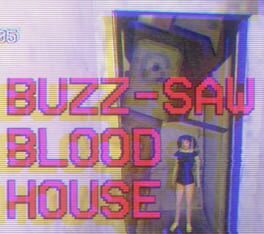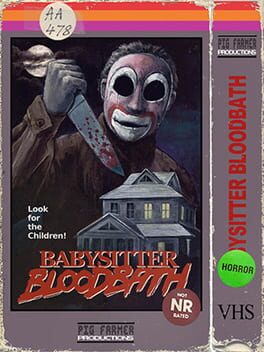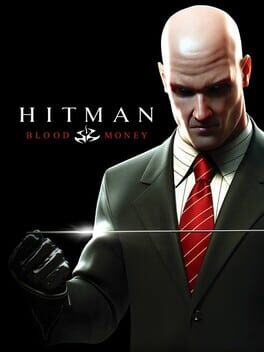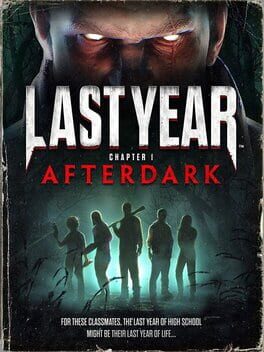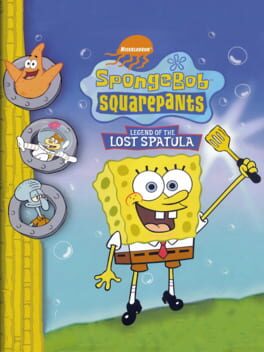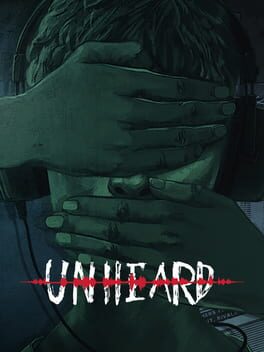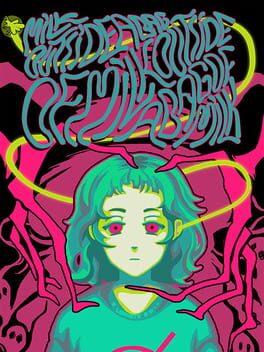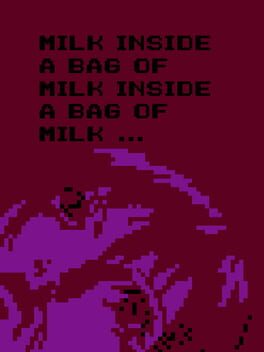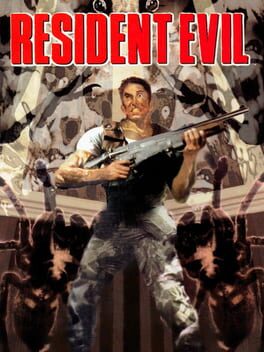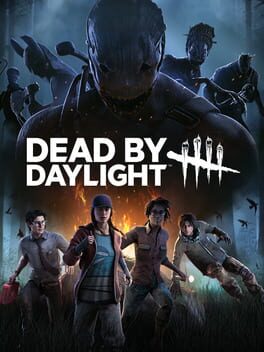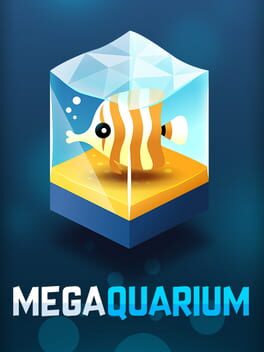dreadicano
2017
Buzz-Saw Blood House is a truly disturbing horror experience that invokes disgust in me that I don't think any other Puppet Combo game could rival. Rather than going for a typical slasher style like their previous games they chose to center this game around the idea of a snuff deep web livestream. Navigating around a house filled with traps and danger, the player must try to aid the escape of a kidnapped school girl who has been the unfortunate subject to this sick exhibition. There is more care and attention given to the introduction, receiving a very classical video game synopsis at the start of the game, detailing a specific instance of one of these kidnapping victims.
You play as multiple victims, each time you die by whatever means, you are replaced by another kidnapped girl, which is a really unsettling concept for a respawn system. In fact, you can still see the remains of your previous attempts litter the environment. These "lives", referred to as copies, can be replenished via pickups in dangerous locations throughout the environment. With each life lost, the show doesn't stop and instead we cut to the moment our next victim arrives in the same room our previous victim couldn't escape from.
The atmosphere is by far the most disturbing of any of the Puppet Combo games I have played thus far. Visually, the low-poly graphics accompanied by the aesthetic that we are watching this from behind a screen makes it very unsettling. The dangerous industrial traps and chainsaws clash with the 'cutsey' approach to the interior design of the rooms, which shows that this place was constructed with every intention to perform this exact purpose, torture and murder innocent girls. These feelings are further enhanced by the "live chat" feature, whereby you will receive commentary on-screen by users of this service who type some of the most deranged and inappropriate things, it really adds another layer of uneasiness to the experience.
Difficult controls and camera perspectives make avoiding the various chainsaws, blades, and other dangers feel genuinely difficult to overcome. Occasionally, chatters in the livestream will donate to trigger a "maniac attack", a brief interval of time where a chainsaw-wielding brute is released in the same room as you, attempting to kill you directly. It's also possible to survive some of these traps if you do screw up, leading to dismemberment and screaming of your player character.
There are several disturbing notes that are displayed in the form of text files that represent the scribblings and thoughts of those who came before you. There are also visual "glitches" or interruptions to the livestream service that are disturbing and startling to the player and often show intermittent footage of the outside world. These things combine to remind me that there must still be someone out there taking these girls for these future trials. Even if you were able to escape and this facility were to be shutdown, the fact this kind of event has an audience of paying customers indicates that another would eventually take its place, at the cost of more innocent lives.
Overall, Buzz-Saw Blood House is terrifying and disgusting in an entirely new way, to the point where it almost feels illegal to play this game. This game is very challenging, and requires a good grasp of the awkward controls and awareness of the potential challenges in various rooms. I honestly think this is one of the most disturbing games of all time, and I would stand my ground by saying this is more fucked up than games like Manhunt.
You play as multiple victims, each time you die by whatever means, you are replaced by another kidnapped girl, which is a really unsettling concept for a respawn system. In fact, you can still see the remains of your previous attempts litter the environment. These "lives", referred to as copies, can be replenished via pickups in dangerous locations throughout the environment. With each life lost, the show doesn't stop and instead we cut to the moment our next victim arrives in the same room our previous victim couldn't escape from.
The atmosphere is by far the most disturbing of any of the Puppet Combo games I have played thus far. Visually, the low-poly graphics accompanied by the aesthetic that we are watching this from behind a screen makes it very unsettling. The dangerous industrial traps and chainsaws clash with the 'cutsey' approach to the interior design of the rooms, which shows that this place was constructed with every intention to perform this exact purpose, torture and murder innocent girls. These feelings are further enhanced by the "live chat" feature, whereby you will receive commentary on-screen by users of this service who type some of the most deranged and inappropriate things, it really adds another layer of uneasiness to the experience.
Difficult controls and camera perspectives make avoiding the various chainsaws, blades, and other dangers feel genuinely difficult to overcome. Occasionally, chatters in the livestream will donate to trigger a "maniac attack", a brief interval of time where a chainsaw-wielding brute is released in the same room as you, attempting to kill you directly. It's also possible to survive some of these traps if you do screw up, leading to dismemberment and screaming of your player character.
There are several disturbing notes that are displayed in the form of text files that represent the scribblings and thoughts of those who came before you. There are also visual "glitches" or interruptions to the livestream service that are disturbing and startling to the player and often show intermittent footage of the outside world. These things combine to remind me that there must still be someone out there taking these girls for these future trials. Even if you were able to escape and this facility were to be shutdown, the fact this kind of event has an audience of paying customers indicates that another would eventually take its place, at the cost of more innocent lives.
Overall, Buzz-Saw Blood House is terrifying and disgusting in an entirely new way, to the point where it almost feels illegal to play this game. This game is very challenging, and requires a good grasp of the awkward controls and awareness of the potential challenges in various rooms. I honestly think this is one of the most disturbing games of all time, and I would stand my ground by saying this is more fucked up than games like Manhunt.
2016
Texas Butcher is nothing more than a glorified gameplay demo in it's entirety, and is an early build for a concept where the player is able to play as the killer rather than a helpless survivor. New gameplay mechanics are added to this title, including a "shadow" mechanic that reflects your visual notoriety and a "noise" mechanic that represents how silent your approach is. Puppet Combo also developed a relatively simple driving mechanic for this title, which at the time of writing, I am unaware if they will utilise in later titles.
Where I thought Puppet Combo's visual design was excellent in their other titles, here it falls flat. The models are repulsive, the atmosphere is non-existent, and the tension is absent. There are no significant or impressive audio cues other than the constant heavy breathing of the killer. I understand that being overtly critical over something that was clearly an early experiment might seem extreme, but as someone who is exploring Puppet Combo's library, I must be vocal about their shortcomings.
It really feels like Texas Butcher could have been something that could have stayed in-house. Sure it's nice to have some extra content if you're a super-fan of the studio but the product that is here is just underwhelming and a poorly executed set of ideas that are otherwise promising.
Where I thought Puppet Combo's visual design was excellent in their other titles, here it falls flat. The models are repulsive, the atmosphere is non-existent, and the tension is absent. There are no significant or impressive audio cues other than the constant heavy breathing of the killer. I understand that being overtly critical over something that was clearly an early experiment might seem extreme, but as someone who is exploring Puppet Combo's library, I must be vocal about their shortcomings.
It really feels like Texas Butcher could have been something that could have stayed in-house. Sure it's nice to have some extra content if you're a super-fan of the studio but the product that is here is just underwhelming and a poorly executed set of ideas that are otherwise promising.
2013
Babysitter Bloodbath is a short horror experience that pays homage to early slasher flicks such as the Halloween franchise. In fact, this game was initially developed as a fan game for Halloween, but due to copyright issues the game was reworked into an original title.
Alike the aforementioned movie, Babysitter Bloodbath follows the story of a young babysitter named Sarah, who quickly finds herself being stalked and pursued by a deranged mask-wielding killer. Compared to Puppet Combo's next title Power Drill Massacre, this game does a much better job of creating a more complete horror experience. In Power Drill Massacre encounters with the killer felt cheap, random, and unfairly forced. In Babysitter Bloodbath the interactions with the killer feel more natural and intentional, while the jumpscares are less jarring but still impactful.
There are more characters and dialogue, which albeit are corny, but they do a better job of making these characters easier to like and the stakes thereby feel higher. Coupled with this are more puzzles, this includes smaller challenges like making cereal and finding liquor but also include more intense problems that involve avoiding the threats in the house whilst finding key items for progression.
One standout moment occurs during a specific set piece when the killer approaches the player, and the camera splits, providing different perspectives, including the killer's as he approaches. This did a really good job of invoking an innate sense of panic immediately in the player, establishing a fairer horror experience compared to their previous title which is much appreciated.
Puppet Combo hits it out of the park with the atmosphere again through the marriage of slasher movies and retro video games to create something truly special. Throughout the game, Babysitter Bloodbath pays homage to several classical horror tropes and sprinkles in some ironic humour that couples well. The more effective balance in these elements creates more suspense, and the tension crescendo is well-designed compared to Power Drill Massacre.
Some players may struggle with the visual design, clunky controls, and the claustrophobic camera, regardless of the chosen style. However, these aspects contribute to the game's tension. Overall, Babysitter Bloodbath represents a fantastic start for Puppet Combo, but it would benefit from additional features such as multiple endings and potentially further chapters to enhance replayability and deepen the core concepts.
Alike the aforementioned movie, Babysitter Bloodbath follows the story of a young babysitter named Sarah, who quickly finds herself being stalked and pursued by a deranged mask-wielding killer. Compared to Puppet Combo's next title Power Drill Massacre, this game does a much better job of creating a more complete horror experience. In Power Drill Massacre encounters with the killer felt cheap, random, and unfairly forced. In Babysitter Bloodbath the interactions with the killer feel more natural and intentional, while the jumpscares are less jarring but still impactful.
There are more characters and dialogue, which albeit are corny, but they do a better job of making these characters easier to like and the stakes thereby feel higher. Coupled with this are more puzzles, this includes smaller challenges like making cereal and finding liquor but also include more intense problems that involve avoiding the threats in the house whilst finding key items for progression.
One standout moment occurs during a specific set piece when the killer approaches the player, and the camera splits, providing different perspectives, including the killer's as he approaches. This did a really good job of invoking an innate sense of panic immediately in the player, establishing a fairer horror experience compared to their previous title which is much appreciated.
Puppet Combo hits it out of the park with the atmosphere again through the marriage of slasher movies and retro video games to create something truly special. Throughout the game, Babysitter Bloodbath pays homage to several classical horror tropes and sprinkles in some ironic humour that couples well. The more effective balance in these elements creates more suspense, and the tension crescendo is well-designed compared to Power Drill Massacre.
Some players may struggle with the visual design, clunky controls, and the claustrophobic camera, regardless of the chosen style. However, these aspects contribute to the game's tension. Overall, Babysitter Bloodbath represents a fantastic start for Puppet Combo, but it would benefit from additional features such as multiple endings and potentially further chapters to enhance replayability and deepen the core concepts.
2015
Power Drill Massacre is Puppet Combo's first fully original video game and with all due respect to the studio, it sure does feel like it. It feels more like a concept demo than a full fledged video game and can be beaten in less than 30 minutes.
Plaudits have to be given to the atmosphere. Power Drill Massacre was released in 2015, and attempts to bring back the retro horror feeling that was associated with 90s horror VHS tapes and early survival horror titles. This style would become synonymous with Puppet Combo. Whether he was responsible for the reintroduction of this style is not within my knowledge but he is certainly the most renowned developer with this approach to horror titles. It's nice to see that he had a clear vision as a horror game developer from the very beginning, and have only continued to build upon that in subsequent titles.
The premise of Power Drill Massacre is simple, you and your friend get into a car accident and must seek help. In doing so, you become locked in this facility, stalked by a maddened murderer wielding a power drill as a weapon. Finicky controls coupled with genuinely terrifying enemy encounters brings out feelings of hopelessness and dread which serve to deliver the intended experience well. Part of the reason why these encounters are terrifying however, is that they almost feel bullshit. It's hard to see exactly what is causing the threat, and encounters usually end within a few seconds.
There's no combat, just a light exploration within a daunting environment with a few scripted encounters scattered within. There is no voice acting, which would later become an appealing and charming aspect to Puppet Combo titles. After mulling over how I felt about the narrative, I really have mixed feelings surrounding it. It is 100% cliche but the lore is incredibly disturbing when fully understood. A nice touch was the inclusion of multiple endings, this trend would continue throughout Puppet Combo's future library. There are two endings in the game, which involve triggering different set pieces within the facility. They divide into a fairly obvious good and bad ending, with the bad ending in particular being incredibly off-putting to experience.
The game also can't decide whether it wants to give the player camera freedom or fixed camera angles and so allows both, which I think hinders the experience. Horror games that use fixed camera angles correctly will craft every room and experience with a great amount of detail. Each angle carefully provides the player with enough information to entice you to keep going forward, but also hides enough to make the player wary of progressing. The ability to switch the camera in these moments allows the player to circumvent the intended fear that fixed camera angles create, and I would have loved if the game decided on one particular camera style and stuck with it.
Power Drill Massacre can be described as a fine game. It does nothing abhorrent but nothing spectacular. The only thing truly memorable about the experience is the absolutely terrifying jumpscares, whose noise is piercing and can lead to you involuntarily releasing your hand from the keyboard out of shock. It's legacy would be that it proved there was a market for this style of game, that Puppet Combo would later evolve this primordial title into more special experiences.
Plaudits have to be given to the atmosphere. Power Drill Massacre was released in 2015, and attempts to bring back the retro horror feeling that was associated with 90s horror VHS tapes and early survival horror titles. This style would become synonymous with Puppet Combo. Whether he was responsible for the reintroduction of this style is not within my knowledge but he is certainly the most renowned developer with this approach to horror titles. It's nice to see that he had a clear vision as a horror game developer from the very beginning, and have only continued to build upon that in subsequent titles.
The premise of Power Drill Massacre is simple, you and your friend get into a car accident and must seek help. In doing so, you become locked in this facility, stalked by a maddened murderer wielding a power drill as a weapon. Finicky controls coupled with genuinely terrifying enemy encounters brings out feelings of hopelessness and dread which serve to deliver the intended experience well. Part of the reason why these encounters are terrifying however, is that they almost feel bullshit. It's hard to see exactly what is causing the threat, and encounters usually end within a few seconds.
There's no combat, just a light exploration within a daunting environment with a few scripted encounters scattered within. There is no voice acting, which would later become an appealing and charming aspect to Puppet Combo titles. After mulling over how I felt about the narrative, I really have mixed feelings surrounding it. It is 100% cliche but the lore is incredibly disturbing when fully understood. A nice touch was the inclusion of multiple endings, this trend would continue throughout Puppet Combo's future library. There are two endings in the game, which involve triggering different set pieces within the facility. They divide into a fairly obvious good and bad ending, with the bad ending in particular being incredibly off-putting to experience.
The game also can't decide whether it wants to give the player camera freedom or fixed camera angles and so allows both, which I think hinders the experience. Horror games that use fixed camera angles correctly will craft every room and experience with a great amount of detail. Each angle carefully provides the player with enough information to entice you to keep going forward, but also hides enough to make the player wary of progressing. The ability to switch the camera in these moments allows the player to circumvent the intended fear that fixed camera angles create, and I would have loved if the game decided on one particular camera style and stuck with it.
Power Drill Massacre can be described as a fine game. It does nothing abhorrent but nothing spectacular. The only thing truly memorable about the experience is the absolutely terrifying jumpscares, whose noise is piercing and can lead to you involuntarily releasing your hand from the keyboard out of shock. It's legacy would be that it proved there was a market for this style of game, that Puppet Combo would later evolve this primordial title into more special experiences.
2006
Hitman: Blood Money stands out in my mind as one of the most fun experiences I've ever had the pleasure of experiencing in the medium. Despite being released in 2006, Blood Money's sandbox level design is unmatched, to a point where it has aged perfectly and still stands out as one of the most fun experiences within the genre even though it's almost two decades old.
Blood Money provides you with a plethora of extremely fun scenarios, offers ideas, but ultimately allows the player to utilise their creativity and make their own decisions as to how they'd like to complete the missions. Every single mission breathes personality and style, allowing the player to perform assassinations at an opera theatre, casino, Mississippi wedding, a wine vinyard, and a suburban neighbourhood, to name a few of the locales. I cannot overstate how incredible these missions are. Each mission is meticulous in it's design, offering several solutions to the player, and through a combination of stealth and brutality, players must overcome these challenges and successfully take out their targets through whatever means.
The player's actions are monitored throughout the game and are evaluated to the player via a results screen at the end of each level, but also narratively in the form of newspaper articles. These articles highlight the number of casualties that occurred, if the player is loud and obvious in their assassination you may develop notoriety between missions, which can affect your ability to perform stealthily in subsequent stages. Security may also gain an understanding of how Agent 47 looks, and so will be more aware of you approaching them as they will be on the lookout for you. This adds a level of complexity of player consequence, and is extremely intuitive for the time.
Although I appreciate the level and audio design, the character design in Blood Money is downright awful. I also had some technical issues replaying this game on modern hardware, cutscenes lacked audio at times, and I found the control scheme a little dated. However, none of these issues are anywhere near significant enough to take away from the plethora of praises I have for this title.
Blood Money's combat is also a little clunky, but I find that necessary. The game after all wants you to have consideration in when you decide to go loud or kill a non-target. The stealth mechanics work fantastically, the AI isn't particularly attentive, but I personally love that it is forgiving and almost cartoonish in it's approach for stealth. For example, being able to throw coins down hallways to lure guards is just fun to pull off. Even routes the game wants you to avoid taking may be circumvented by learning the game's mechanics and exploiting that.
My favourite mechanic is definitely the ability to incapacitate people of interest, and wearing their attire to disguise as them. This allows you to freely access certain areas, e.g. dressing as a chef to freely walk the kitchen and catering area, or dressing as a security guard to close the gap between you and your target.
Of course, for loud approaches there are several firearms that you can use, such as snipers, shotguns, SMGs, and the famous Silverballers pistols. But my favourite arsenal is that of your stealth equipment. Fiber wire to take out your target up close or even sedative and poison syringes to be used on people directly, or indirectly through food and water.
There of course are narrative reasons for each of the assassinations, and a fairly decent plot to connect the threads together. However, I found the story supplementary, it was not an important selling aspect to the game for me at all. That's the beauty of this wonderful medium, some games weave interesting tales with overarching plot threads that surprise you in ways that no other medium could. However, some games, like Hitman: Blood Money are purely and simply fun to play, and it's these innovative games that become timeless.
Blood Money provides you with a plethora of extremely fun scenarios, offers ideas, but ultimately allows the player to utilise their creativity and make their own decisions as to how they'd like to complete the missions. Every single mission breathes personality and style, allowing the player to perform assassinations at an opera theatre, casino, Mississippi wedding, a wine vinyard, and a suburban neighbourhood, to name a few of the locales. I cannot overstate how incredible these missions are. Each mission is meticulous in it's design, offering several solutions to the player, and through a combination of stealth and brutality, players must overcome these challenges and successfully take out their targets through whatever means.
The player's actions are monitored throughout the game and are evaluated to the player via a results screen at the end of each level, but also narratively in the form of newspaper articles. These articles highlight the number of casualties that occurred, if the player is loud and obvious in their assassination you may develop notoriety between missions, which can affect your ability to perform stealthily in subsequent stages. Security may also gain an understanding of how Agent 47 looks, and so will be more aware of you approaching them as they will be on the lookout for you. This adds a level of complexity of player consequence, and is extremely intuitive for the time.
Although I appreciate the level and audio design, the character design in Blood Money is downright awful. I also had some technical issues replaying this game on modern hardware, cutscenes lacked audio at times, and I found the control scheme a little dated. However, none of these issues are anywhere near significant enough to take away from the plethora of praises I have for this title.
Blood Money's combat is also a little clunky, but I find that necessary. The game after all wants you to have consideration in when you decide to go loud or kill a non-target. The stealth mechanics work fantastically, the AI isn't particularly attentive, but I personally love that it is forgiving and almost cartoonish in it's approach for stealth. For example, being able to throw coins down hallways to lure guards is just fun to pull off. Even routes the game wants you to avoid taking may be circumvented by learning the game's mechanics and exploiting that.
My favourite mechanic is definitely the ability to incapacitate people of interest, and wearing their attire to disguise as them. This allows you to freely access certain areas, e.g. dressing as a chef to freely walk the kitchen and catering area, or dressing as a security guard to close the gap between you and your target.
Of course, for loud approaches there are several firearms that you can use, such as snipers, shotguns, SMGs, and the famous Silverballers pistols. But my favourite arsenal is that of your stealth equipment. Fiber wire to take out your target up close or even sedative and poison syringes to be used on people directly, or indirectly through food and water.
There of course are narrative reasons for each of the assassinations, and a fairly decent plot to connect the threads together. However, I found the story supplementary, it was not an important selling aspect to the game for me at all. That's the beauty of this wonderful medium, some games weave interesting tales with overarching plot threads that surprise you in ways that no other medium could. However, some games, like Hitman: Blood Money are purely and simply fun to play, and it's these innovative games that become timeless.
2019
Last Year can be summarised quite simply as a game with intention but no direction. Taking clear inspiration from Dead By Daylight, Last Year tries to develop the asymmetrical horror video game genre. I understand this game went through development hell, and has been released on various different platforms at different price points. However, at the time of writing, Last Year was recently released for free on Steam. I decided to give it a try given the small bump in playerbase and I found it to be a real mixed bag.
Environments are visually fantastic and combined with some of the gameplay mechanics, such as traps and spiders, it establishes an atmosphere that makes it uncomfortable to explore.
The fiends are fun to play, but visually the design leaves a lot to be desired, and doesn't quite scratch the itch of other competitor games in the industry. Additionally, the roster is really small, with 4 fiends at the time of releasing. One advantage the fiends have over the classmates is that their cosmetics are much better, with the survivors mostly possessing simple recolours most of the time.
Fiends are able to disappear and reappear when out of the line of sight of other players, allowing you to place traps in key areas, reposition, and set up ambushes. The time to kill in Last Year is extremely fast, with some fiends being particularly strong in combination with traps. Interestingly, survivors possess ways of fighting back, which is a nice idea but mostly futile, and you'll find yourself dying over and over again in order to whittle down the killer's health, or keep him distracted so that your teammates can complete objectives.
This leads to combat, which is extremely floaty and imprecise for both sides, hits never felt satisfying to land, but the execution animations are gnarly. Gameplay involves a lot of scavenging and crafting too, leading to better equipment and skills necessary to put up a stronger fight against the killer. I find the gameplay way more fun from the side of the fiends, but quite a slog from the perspective of the survivors. Survivors have to complete all of the objectives in 15 minutes, able to respawn upon death in "Left 4 Dead"-like rooms, and have different classes which provide the character with inherent skills and different craftables. The base design of the survivors is actually pretty good, but like I alluded to earlier, the available cosmetics are nowhere near good enough to warrant spending the time or money to earn.
The audio design is also extremely polished, things crunch, they pop, they gurgle, and it all serves to add flavourings to the game. Although there is nothing wrong with the voice acting, the script at times is corny, with lines such as "um guys.. i really don't think this is a good idea o.o". I assume the intention was to capture the often goofy and plastic nature of horror characters though which I can excuse.
I do not in any way think Last Year is a bad game conceptually, however during my time with the game, it definitely feels as if something is missing from the experience that doesn't quite give me the hope that this game will live on beyond this initial resuscitation period it's experiencing. The game needs more variety across the board, from cosmetics, to fiends, to survivors, maps and most importantly progression. There are some good ideas here, and I hope the developers continue to work on this game, adding new content throughout and polishing some of the gameplay issues. Free to Play was definitely the correct decision in this case, but without a steady content roadmap, it will stagnate, and I may revisit after a period of time to evaluate the changes.
Environments are visually fantastic and combined with some of the gameplay mechanics, such as traps and spiders, it establishes an atmosphere that makes it uncomfortable to explore.
The fiends are fun to play, but visually the design leaves a lot to be desired, and doesn't quite scratch the itch of other competitor games in the industry. Additionally, the roster is really small, with 4 fiends at the time of releasing. One advantage the fiends have over the classmates is that their cosmetics are much better, with the survivors mostly possessing simple recolours most of the time.
Fiends are able to disappear and reappear when out of the line of sight of other players, allowing you to place traps in key areas, reposition, and set up ambushes. The time to kill in Last Year is extremely fast, with some fiends being particularly strong in combination with traps. Interestingly, survivors possess ways of fighting back, which is a nice idea but mostly futile, and you'll find yourself dying over and over again in order to whittle down the killer's health, or keep him distracted so that your teammates can complete objectives.
This leads to combat, which is extremely floaty and imprecise for both sides, hits never felt satisfying to land, but the execution animations are gnarly. Gameplay involves a lot of scavenging and crafting too, leading to better equipment and skills necessary to put up a stronger fight against the killer. I find the gameplay way more fun from the side of the fiends, but quite a slog from the perspective of the survivors. Survivors have to complete all of the objectives in 15 minutes, able to respawn upon death in "Left 4 Dead"-like rooms, and have different classes which provide the character with inherent skills and different craftables. The base design of the survivors is actually pretty good, but like I alluded to earlier, the available cosmetics are nowhere near good enough to warrant spending the time or money to earn.
The audio design is also extremely polished, things crunch, they pop, they gurgle, and it all serves to add flavourings to the game. Although there is nothing wrong with the voice acting, the script at times is corny, with lines such as "um guys.. i really don't think this is a good idea o.o". I assume the intention was to capture the often goofy and plastic nature of horror characters though which I can excuse.
I do not in any way think Last Year is a bad game conceptually, however during my time with the game, it definitely feels as if something is missing from the experience that doesn't quite give me the hope that this game will live on beyond this initial resuscitation period it's experiencing. The game needs more variety across the board, from cosmetics, to fiends, to survivors, maps and most importantly progression. There are some good ideas here, and I hope the developers continue to work on this game, adding new content throughout and polishing some of the gameplay issues. Free to Play was definitely the correct decision in this case, but without a steady content roadmap, it will stagnate, and I may revisit after a period of time to evaluate the changes.
Last year I embarked on a journey, to beat every single SpongeBob SquarePants video game ever made. I started in chronological order and that brought me to this monstrosity of a videogame which immediately made me cancel my journey and go on a SpongeBob sabbatical retreat to rethink my life and the decisions I had made.
Narratively, the game is simple, SpongeBob essentially goes on a fetch quest to collect oven knobs across Bikini Bottom. This allows him to access the Flying Dutchman's lair, retrieve the golden spatula and become the Master Fry Cook.
Legend of the Lost Spatula is a platformer in all of the wrong ways. SpongeBob is floaty to control, the tiny Game Boy screen obscures the distance of your vision, which prevents you from making accurate jumps, leading to you taking leaps of faith. More often than not, levels are vertical, so you can spend upwards of 10 minutes climbing a level, just to miss a jump, sending your square ass plummeting back down to the depths below.
The game is open world but is unclear in what it exactly wants you to do. Although the open world nature seems like a positive, it can actually lead you to feeling confused as to why this is relevant to the plot, and can lead you to enter areas that are tougher immediately from the beginning which would lead to a highly frustrating time as you familiarize yourself with the dogshit controls.
Enemies are designed in the most punishing fashion. Their placement happens to always be in unforeseen areas and near safe spots when platforming, which if you happen to unfortunately leap into an enemy when traversing between platforms can send you all the way to the beginning of a level. Trust me, you will be undoubtedly hit by enemies over and over again, this game requires you to memorize upcoming platform sections, where the enemies spawn, and their movements.
On top of their placement issues, the weaponry available to SpongeBob is awful. The bubble blower has an attack pattern like a knight from chess, the net launcher only works on certain enemies, the hitbox from the net is inconsistent.
In order to refill these weapons, you'll have to collect treasure chests, which can contain pants (health) and ammunition. Or just randomly provide the phrase "April Fools" before disappearing??? Such a weird writing choice for a SpongeBob game, and further proof to my theory that this game was made by sadists who wanted to troll any and every unlucky soul who considered playing this game.
There's also an item that allows you to see inside of treasure chests, which is by far one of the most useless items in any game I have ever seen because it is necessary to open pretty much every chest you come across, and it saves you a lot of time to just open them rather than navigating through menus to equip and unequip the glasses prior to opening?
The ONLY positives of Legend of the Lost Spatula are the accurate and well-crafted artwork, and some of the music being decent at best. Everything else besides presentation is absolutely horrendous. This game, if not already, should be notorious for it's ruthless game design and is a contender for the most frustrating Game Boy Colour game of all-time.
Narratively, the game is simple, SpongeBob essentially goes on a fetch quest to collect oven knobs across Bikini Bottom. This allows him to access the Flying Dutchman's lair, retrieve the golden spatula and become the Master Fry Cook.
Legend of the Lost Spatula is a platformer in all of the wrong ways. SpongeBob is floaty to control, the tiny Game Boy screen obscures the distance of your vision, which prevents you from making accurate jumps, leading to you taking leaps of faith. More often than not, levels are vertical, so you can spend upwards of 10 minutes climbing a level, just to miss a jump, sending your square ass plummeting back down to the depths below.
The game is open world but is unclear in what it exactly wants you to do. Although the open world nature seems like a positive, it can actually lead you to feeling confused as to why this is relevant to the plot, and can lead you to enter areas that are tougher immediately from the beginning which would lead to a highly frustrating time as you familiarize yourself with the dogshit controls.
Enemies are designed in the most punishing fashion. Their placement happens to always be in unforeseen areas and near safe spots when platforming, which if you happen to unfortunately leap into an enemy when traversing between platforms can send you all the way to the beginning of a level. Trust me, you will be undoubtedly hit by enemies over and over again, this game requires you to memorize upcoming platform sections, where the enemies spawn, and their movements.
On top of their placement issues, the weaponry available to SpongeBob is awful. The bubble blower has an attack pattern like a knight from chess, the net launcher only works on certain enemies, the hitbox from the net is inconsistent.
In order to refill these weapons, you'll have to collect treasure chests, which can contain pants (health) and ammunition. Or just randomly provide the phrase "April Fools" before disappearing??? Such a weird writing choice for a SpongeBob game, and further proof to my theory that this game was made by sadists who wanted to troll any and every unlucky soul who considered playing this game.
There's also an item that allows you to see inside of treasure chests, which is by far one of the most useless items in any game I have ever seen because it is necessary to open pretty much every chest you come across, and it saves you a lot of time to just open them rather than navigating through menus to equip and unequip the glasses prior to opening?
The ONLY positives of Legend of the Lost Spatula are the accurate and well-crafted artwork, and some of the music being decent at best. Everything else besides presentation is absolutely horrendous. This game, if not already, should be notorious for it's ruthless game design and is a contender for the most frustrating Game Boy Colour game of all-time.
2019
Unheard's gameplay is a novel concept which I have never seen utilized before in any form of media. Oftentimes, video games will explore narratives and experiences alike traditional forms of story telling with order, sequence, and crafted story whereby the mystery unravels in a predetermined order.
Unheard takes advantage of the freedom of video game design, allowing players to experience an intricate story with several plot threads, characters, and events occurring simultaneously in front of them. By manipulating time and the position you're listening from, you must solve the mystery behind various crime scenes using nothing but your ears and your brain. This allows you to fastforward, rewind, reset, and skip through the footage accordingly, in order to piece together the story.
Although there are only five cases, with an additional free DLC case (which is fantastic), there is still a great value for money here. Each crime scene increases in difficulty and scale as you progress through the game, offering challenging puzzles that demand careful deductions and active listening. I found myself several times taking notes on pen and paper so I was able to attach the particular voices to their appropriate names and create timelines that allowed me to solve each of the crime scenes. This was incredibly rewarding, I've played plenty of difficult puzzle games before, but none have required me to write things down and evaluate and compare my findings. This is the closest I've felt to what we think detectives do on a daily basis in fiction, and it was truly an unforgettable game.
The Final Script crime scene which is a free DLC case that you can install, is by far my favourite, taking several hours for me to solve. As you'd expect from a game designed around listening, you can expect solid vocal performances throughout. However, I do have criticisms with the general overarching story. Although the narrative of each of the individual cases is fantastic, I personally found a lot of the added context between the cases that attempted to connect them and explain how this was happening was unnecessary. I sincerely hope that NEXT Studios are working on a sequel, with more crime scenes, because this game was a delight from start to finish.
Unheard takes advantage of the freedom of video game design, allowing players to experience an intricate story with several plot threads, characters, and events occurring simultaneously in front of them. By manipulating time and the position you're listening from, you must solve the mystery behind various crime scenes using nothing but your ears and your brain. This allows you to fastforward, rewind, reset, and skip through the footage accordingly, in order to piece together the story.
Although there are only five cases, with an additional free DLC case (which is fantastic), there is still a great value for money here. Each crime scene increases in difficulty and scale as you progress through the game, offering challenging puzzles that demand careful deductions and active listening. I found myself several times taking notes on pen and paper so I was able to attach the particular voices to their appropriate names and create timelines that allowed me to solve each of the crime scenes. This was incredibly rewarding, I've played plenty of difficult puzzle games before, but none have required me to write things down and evaluate and compare my findings. This is the closest I've felt to what we think detectives do on a daily basis in fiction, and it was truly an unforgettable game.
The Final Script crime scene which is a free DLC case that you can install, is by far my favourite, taking several hours for me to solve. As you'd expect from a game designed around listening, you can expect solid vocal performances throughout. However, I do have criticisms with the general overarching story. Although the narrative of each of the individual cases is fantastic, I personally found a lot of the added context between the cases that attempted to connect them and explain how this was happening was unnecessary. I sincerely hope that NEXT Studios are working on a sequel, with more crime scenes, because this game was a delight from start to finish.
Milk outside a bag of milk outside a bag of milk elevates the ingredients that made the first installment so intriguing. This game creates such a stronger atmosphere than the first, escalating it with techniques similar to what we see in analogue horror, with fourth wall breaks and uncanny happenings. An immediate improvement is noticed with the art direction, with some segments receiving animated sequences that look great. The colour palette is fantastic, and visually the game is unique and much clearer than Milk Inside. The soundtrack and sound effects are used sparingly and couple well together to contribute to a higher quality product in every regard.
Narratively, the game continues where Milk Inside left off, and continues the struggle of this young woman with her mental health, trauma, and medication. This serves to explore these ideas and themes that were established with the first game in a much deeper way, now with several endings to achieve, resulting in a different dream sequence depending on our actions within the bedroom.
For all these quality of life improvements, I still think Milk Outside was unable to hit the expectations I had for the game. Although prettier, the game isn't significantly longer than the first, and I still think there is a greater amount of potential that can be told with the ideas here. The story is almost too symbolic with it's messaging, some endings are entirely unclear with what they represent. The significance of her trauma is also a mystery, which I think provides a disservice for this game as there are several factors. However, I do appreciate that the representation of the mental health struggles being generic allows players to project their own experiences onto the game and thereby relate. Her mental health struggles have motifs similar to anxiety, depression, OCD, ADHD, autism, schizophrenia, PTSD, etc. The game however, feels a lucid representation of these themes, rather than a striking narrative that would explore these struggles in a more meaningful way.
Narratively, the game continues where Milk Inside left off, and continues the struggle of this young woman with her mental health, trauma, and medication. This serves to explore these ideas and themes that were established with the first game in a much deeper way, now with several endings to achieve, resulting in a different dream sequence depending on our actions within the bedroom.
For all these quality of life improvements, I still think Milk Outside was unable to hit the expectations I had for the game. Although prettier, the game isn't significantly longer than the first, and I still think there is a greater amount of potential that can be told with the ideas here. The story is almost too symbolic with it's messaging, some endings are entirely unclear with what they represent. The significance of her trauma is also a mystery, which I think provides a disservice for this game as there are several factors. However, I do appreciate that the representation of the mental health struggles being generic allows players to project their own experiences onto the game and thereby relate. Her mental health struggles have motifs similar to anxiety, depression, OCD, ADHD, autism, schizophrenia, PTSD, etc. The game however, feels a lucid representation of these themes, rather than a striking narrative that would explore these struggles in a more meaningful way.
Milk inside a bag of milk inside a bag of milk is a short interactive experience that intends to capture the emotional suffrage that can accompany someone who suffers with mental illness. We accompany a young girl, and explore the suffocating thought process burdening her as a result of her mental health. Although her particular condition is never revealed to the player, I think the game does a great job of representing how mental health can impact simple tasks, such as going out to buy milk and as someone with anxiety, I do relate to a lot of the thought processes explored.
This game is incredibly short, taking me less than 20m to complete. I found the art direction of the game intriguing, but at times extremely hard to make out what exactly was going on, although I think this was the developers intention, leaving the majority of this game up to the interpretation of the player. Milk inside a bag of milk inside a bag of milk was far from a great visual novel game, but it's psychological horror elements coupled with mental health representation make this game memorable despite that. I believe Nikita Kryukov was able to express their vision with more polish and artistically with the sequel which is much better.
This game is incredibly short, taking me less than 20m to complete. I found the art direction of the game intriguing, but at times extremely hard to make out what exactly was going on, although I think this was the developers intention, leaving the majority of this game up to the interpretation of the player. Milk inside a bag of milk inside a bag of milk was far from a great visual novel game, but it's psychological horror elements coupled with mental health representation make this game memorable despite that. I believe Nikita Kryukov was able to express their vision with more polish and artistically with the sequel which is much better.
1996
Contextualising Resident Evil with other titles released in 1996, it stands out as one of the most prolific of the year. Providing a fantastic start to the world of survival horror, Resident Evil still remains relevant 25 years later. The sheer amount of ports, remakes, and clones of this ground-breaking title should speak for itself. The challenging puzzles, chilling atmosphere, and "charming" characters define Resident Evil as a game that can be enjoyed in its clunky original state.
The original Resident Evil is almost a masterpiece in every offerable asset. For instance, the multi-layered thought process in it's puzzle design. Enemy placement is calculated, demanding the player to consider their ammunition and health resources in an encounter. Players must therefore be conservative of their supplies, or skilled in enemy manipulation and tank control movement in order to circumvent the threats throughout the mansion. Additionally, there are several multi-step puzzles that must be solved, that require thorough planning and excellent inventory management skills. Even the simplest actions like saving your game becomes a resource in Resident Evil, which adds a further layer of complexity, as there are a limited number of these in the game.
You'd think the poor quality voice acting of the original coupled with the relatively simple narrative would render these aspects of the game unenjoyable yet that isn't the case. Resident Evil manages to capture the spirit of a cheap indie B-movie horror flick, and thanks to it's confusing performances and terrible script as a result of poor translations from Japanese, the game somehow oozes charm throughout.
This stands in stark contrast with the foreboding atmosphere the game is able to create, through it's excellent environmental design, iconic soundtrack, and well crafted enemy noises. Resident Evil is a case study of visionary creativity, with every facet thoroughly considered. It is at it's strongest when the game is conveying it's story subtly through the environment and file text.
Going into this game completely blind is an incredibly challenging experience. You will undoubtedly make mistakes, lose progress, run out of healing items, fire your last bullet, but to master a game like this is incredibly rewarding. Resident Evil was designed to be replayed in a variety of ways. Firstly, there are two completely separate campaigns depending on the character you chose, which would change the story, gameplay, and difficulty significantly. Secondly, there are plenty of rewards such as alternate costumes and infinite ammo weaponry which are unlocked after completing various challenge runs, such as beating the game in under 3 hours, or achieving the best ending.
Within the realm of video games, Resident Evil is more than the inception of one of gaming's most iconic franchises, but it is a significant cultural event within the industry. It pioneered a brand new genre, and took advantage of the technology available to drag the rest of the industry forward with it. In my opinion, Resident Evil is the most impactful video game of its generation.
The original Resident Evil is almost a masterpiece in every offerable asset. For instance, the multi-layered thought process in it's puzzle design. Enemy placement is calculated, demanding the player to consider their ammunition and health resources in an encounter. Players must therefore be conservative of their supplies, or skilled in enemy manipulation and tank control movement in order to circumvent the threats throughout the mansion. Additionally, there are several multi-step puzzles that must be solved, that require thorough planning and excellent inventory management skills. Even the simplest actions like saving your game becomes a resource in Resident Evil, which adds a further layer of complexity, as there are a limited number of these in the game.
You'd think the poor quality voice acting of the original coupled with the relatively simple narrative would render these aspects of the game unenjoyable yet that isn't the case. Resident Evil manages to capture the spirit of a cheap indie B-movie horror flick, and thanks to it's confusing performances and terrible script as a result of poor translations from Japanese, the game somehow oozes charm throughout.
This stands in stark contrast with the foreboding atmosphere the game is able to create, through it's excellent environmental design, iconic soundtrack, and well crafted enemy noises. Resident Evil is a case study of visionary creativity, with every facet thoroughly considered. It is at it's strongest when the game is conveying it's story subtly through the environment and file text.
Going into this game completely blind is an incredibly challenging experience. You will undoubtedly make mistakes, lose progress, run out of healing items, fire your last bullet, but to master a game like this is incredibly rewarding. Resident Evil was designed to be replayed in a variety of ways. Firstly, there are two completely separate campaigns depending on the character you chose, which would change the story, gameplay, and difficulty significantly. Secondly, there are plenty of rewards such as alternate costumes and infinite ammo weaponry which are unlocked after completing various challenge runs, such as beating the game in under 3 hours, or achieving the best ending.
Within the realm of video games, Resident Evil is more than the inception of one of gaming's most iconic franchises, but it is a significant cultural event within the industry. It pioneered a brand new genre, and took advantage of the technology available to drag the rest of the industry forward with it. In my opinion, Resident Evil is the most impactful video game of its generation.
2016
Inside is a game I've heard about for quite some time but I hadn't gotten around to playing it until now and I am so shocked by the quality of this game.
Immediately, Inside immerses you into it's dystopian world through it's fantastic qualities. Perfectly crafted audio design coupled with the daunting soundtrack work in tandem to create tension, peace, and horror throughout the game. Visually the game design is simple but timeless and Playdead did a fantastic job of utilizing these features to create one of the best unsettling atmospheres I have ever seen in a videogame.
Inside begins with a cold open, not a single word of dialogue is spoken, yet somehow convinces the player to care deeply about this boy's journey, as you guide him throughout treacherous territory. Challenging puzzles and intense action set-pieces are extremely well done, and I found myself really having to think about my next decision, finding pride in my intuition when I got something right the first time.
Achievements are tied to secret collectibles that can be found throughout the game and most are extremely well hidden and off the beaten path, and I'd recommend using a guide to attain them. There is also an alternate secret ending that you should look up afterwards.
Story-wise, the game is open for interpretation, and you discover more nefarious things happening throughout the plot and this game really gets more dark and twisted as you progress. Several times throughout the game I felt so uncomfortable with what was going on (in a good way), I highly recommend going in blind and allowing Playdead to take you on this journey.
I simply cannot fault the game, it didn't overstay it's welcome, but I didn't crave more once it was over. The stakes were raised with each progression point, and the puzzles coupled with the atmosphere makes this honestly one of my favourite experiences I have had to date with the genre.
Immediately, Inside immerses you into it's dystopian world through it's fantastic qualities. Perfectly crafted audio design coupled with the daunting soundtrack work in tandem to create tension, peace, and horror throughout the game. Visually the game design is simple but timeless and Playdead did a fantastic job of utilizing these features to create one of the best unsettling atmospheres I have ever seen in a videogame.
Inside begins with a cold open, not a single word of dialogue is spoken, yet somehow convinces the player to care deeply about this boy's journey, as you guide him throughout treacherous territory. Challenging puzzles and intense action set-pieces are extremely well done, and I found myself really having to think about my next decision, finding pride in my intuition when I got something right the first time.
Achievements are tied to secret collectibles that can be found throughout the game and most are extremely well hidden and off the beaten path, and I'd recommend using a guide to attain them. There is also an alternate secret ending that you should look up afterwards.
Story-wise, the game is open for interpretation, and you discover more nefarious things happening throughout the plot and this game really gets more dark and twisted as you progress. Several times throughout the game I felt so uncomfortable with what was going on (in a good way), I highly recommend going in blind and allowing Playdead to take you on this journey.
I simply cannot fault the game, it didn't overstay it's welcome, but I didn't crave more once it was over. The stakes were raised with each progression point, and the puzzles coupled with the atmosphere makes this honestly one of my favourite experiences I have had to date with the genre.
2023
This game is difficult to review as it is unapologetically short, simple, and absurd. It's a bizarre little game that has the player exploring a colourful island, witnessing various events and interacting with objects for achievements. Towards the end of the game, an event happens that changes the atmosphere of the island completely. This is where the game shines, as there are tonnes of morbid details and the game's humour works well to highlight these events. Accompanying the game is the wonderful soundtrack that absolutely is the best feature of the game.
Pineapple on pizza can be beaten in ~5 minutes. Therefore, if you're curious, I don't see the harm in trying it out as it is totally free. It's hard to hold the criticisms I have too harshly against the game because it is self-aware in it's presentation. I personally do not agree with the heavy plaudits this game has received, and I found it to be a mediocre experience at best and not memorable in the slightest. But I recognize I'm in the minority and I encourage you to give it a shot and see what you think.
Pineapple on pizza can be beaten in ~5 minutes. Therefore, if you're curious, I don't see the harm in trying it out as it is totally free. It's hard to hold the criticisms I have too harshly against the game because it is self-aware in it's presentation. I personally do not agree with the heavy plaudits this game has received, and I found it to be a mediocre experience at best and not memorable in the slightest. But I recognize I'm in the minority and I encourage you to give it a shot and see what you think.
2016
Despite the overwhelming criticism this game receives, I still find myself coming back to this title over and over. To start with, I do have some bias, as a massive fan of the horror genre, this game is my Nicktoons crossover special episode. However, one statement I am confident is true, is that at the time of writing, this is the best asymmetrical multiplayer videogame on the market right now.
Where many games have attempted to ride the wave of Dead By Daylights success, this game remains extremely popular and has a huge playerbase with an overall mixed community. Most clones or similar games make playing survivor feel like a chore, or that you drew the short straw. But DBD makes playing survivor exhilarating, and I oftentimes feel myself prefer to play survivor over killer in most situations.
For as imperfect as the game is, it's gameplay is certainly unique and offers original and gameplay that doesn't get tiring. Each killer encourages a different playstyle entirely to make the use of their unique moveset and abilities. Survivors can also highly customize their skins, perks, and add-ons that allow for various different playstyles and strategies on a game-by-game basis.
The characters available are one of my favourite aspects of DBD, with fantastic character models for original killers and survivors, excellent cosmetic skins, and some of the most iconic licensed killers to have fun with.
DBD will continue to be scary throughout your playime. At first, every map is uncharted and the abilities of every killer are unknown, which leads to definitely the most horrifying atmosphere. Eventually, when you get good at the game, this novelty does wear off, however, as you improve, so does the opposition you play against. This may lead to scenarios where you become outwitted or taken by surprise and has led to me shitting many pairs of pants.
However, the game does receive its fair share of criticism and I do have to agree with a lot of it. Despite Behaviour Interactive's good intentions and regular support and updates of the game, the meta changes fairly often as a result of these changes which frustrate a lot of players who main certain killers or utilize certain survivor perks. This can make the gameplay feel unbalanced to newer players, however, I believe skilled players can find workarounds to these issues by utilising different perks or tactics.
I do think the reliance on DLC content for some of the best builds in the game is a valid criticism too. Although these DLC regularly do go on sale, I don't think there's any valid excuse to paywall content that provides players with advantages.
The community is extremely mixed for both survivors and killers. A killer may assist the last survivor and show them mercy and allow them to escape in one game, yet in the next game, they may get tunneled and rehooked repetitively until death. Despite the occasional unsportsmanlike behaviour, I do find that the community is overall an inclusive and positive space.
There is also an incredibly steep learning curve to the game, and so it is very hard for new players to come into the game blind. There are tonnes of perks to be aware of, killer utility, generator locations, quick time events, looping strategies, learning how to avoid making noise etc.
Connection issues also play a significant role in the enjoyability of the game. Sometimes there is a ping difference between the survivors and killer and so actions that appear to hit will depend on the server latency and individual pings, which can render "certified strategies" mistimed.
Despite the honest criticisms, I still thoroughly enjoy playing the game. I am talking from the perspective of someone who has hundreds of hours however, and thereby I am able to have consistently good games and I recognise my bias, but I still love this game and have always found it fun, despite the hardships.
Where many games have attempted to ride the wave of Dead By Daylights success, this game remains extremely popular and has a huge playerbase with an overall mixed community. Most clones or similar games make playing survivor feel like a chore, or that you drew the short straw. But DBD makes playing survivor exhilarating, and I oftentimes feel myself prefer to play survivor over killer in most situations.
For as imperfect as the game is, it's gameplay is certainly unique and offers original and gameplay that doesn't get tiring. Each killer encourages a different playstyle entirely to make the use of their unique moveset and abilities. Survivors can also highly customize their skins, perks, and add-ons that allow for various different playstyles and strategies on a game-by-game basis.
The characters available are one of my favourite aspects of DBD, with fantastic character models for original killers and survivors, excellent cosmetic skins, and some of the most iconic licensed killers to have fun with.
DBD will continue to be scary throughout your playime. At first, every map is uncharted and the abilities of every killer are unknown, which leads to definitely the most horrifying atmosphere. Eventually, when you get good at the game, this novelty does wear off, however, as you improve, so does the opposition you play against. This may lead to scenarios where you become outwitted or taken by surprise and has led to me shitting many pairs of pants.
However, the game does receive its fair share of criticism and I do have to agree with a lot of it. Despite Behaviour Interactive's good intentions and regular support and updates of the game, the meta changes fairly often as a result of these changes which frustrate a lot of players who main certain killers or utilize certain survivor perks. This can make the gameplay feel unbalanced to newer players, however, I believe skilled players can find workarounds to these issues by utilising different perks or tactics.
I do think the reliance on DLC content for some of the best builds in the game is a valid criticism too. Although these DLC regularly do go on sale, I don't think there's any valid excuse to paywall content that provides players with advantages.
The community is extremely mixed for both survivors and killers. A killer may assist the last survivor and show them mercy and allow them to escape in one game, yet in the next game, they may get tunneled and rehooked repetitively until death. Despite the occasional unsportsmanlike behaviour, I do find that the community is overall an inclusive and positive space.
There is also an incredibly steep learning curve to the game, and so it is very hard for new players to come into the game blind. There are tonnes of perks to be aware of, killer utility, generator locations, quick time events, looping strategies, learning how to avoid making noise etc.
Connection issues also play a significant role in the enjoyability of the game. Sometimes there is a ping difference between the survivors and killer and so actions that appear to hit will depend on the server latency and individual pings, which can render "certified strategies" mistimed.
Despite the honest criticisms, I still thoroughly enjoy playing the game. I am talking from the perspective of someone who has hundreds of hours however, and thereby I am able to have consistently good games and I recognise my bias, but I still love this game and have always found it fun, despite the hardships.
2018
I picked this game up when I wanted to scratch that classic tycoon/management sim itch I had and this game did not disappoint in that regard. Megaquarium is one of the easiest to grasp simulation games I have ever played, and although the challenge is fun, especially at the beginning, once you have learned how to take advantage of the games mechanics, the game becomes a breeze, and the only thing that will stop your progression is the long time it takes to prestige.
Despite the lack of difficulty the game is still engaging throughout. There is a significant amount of freedom given to the player which allows you to customize your aquarium in whatever fashion you choose. There are several different tanks and decorations that allow you to design your aquarium with a lot of finesse.
There is a lot of educational value from the game, as it provides a good opportunity to pick up some information about the marine life of some of these animals. Each animal will have its own unique needs, and its a challenge to design interesting exhibits for your guests. However, I would describe the amount of animals as moderate, but what makes up for the absence of various fish is the Steam workshop functionality, that allows you to download community made fish for your aquarium, that adds further replayability thanks to the fish nerds ✊🐟.
The game does a great job at making sure the learning curve isn't too steep, the campaign serves as an excellent tutorial, guiding you with various challenges and mechanics over the course of several lengthy levels. At any time, you can also access the sandbox mode, that's fully customisable and comes with various challenges that add even more layers of replayability.
I definitely recommend checking this game out for more casual enjoyers of the genre, although the community content will add more replayability and difficulty would satisfy avid simulation players.
Despite the lack of difficulty the game is still engaging throughout. There is a significant amount of freedom given to the player which allows you to customize your aquarium in whatever fashion you choose. There are several different tanks and decorations that allow you to design your aquarium with a lot of finesse.
There is a lot of educational value from the game, as it provides a good opportunity to pick up some information about the marine life of some of these animals. Each animal will have its own unique needs, and its a challenge to design interesting exhibits for your guests. However, I would describe the amount of animals as moderate, but what makes up for the absence of various fish is the Steam workshop functionality, that allows you to download community made fish for your aquarium, that adds further replayability thanks to the fish nerds ✊🐟.
The game does a great job at making sure the learning curve isn't too steep, the campaign serves as an excellent tutorial, guiding you with various challenges and mechanics over the course of several lengthy levels. At any time, you can also access the sandbox mode, that's fully customisable and comes with various challenges that add even more layers of replayability.
I definitely recommend checking this game out for more casual enjoyers of the genre, although the community content will add more replayability and difficulty would satisfy avid simulation players.
